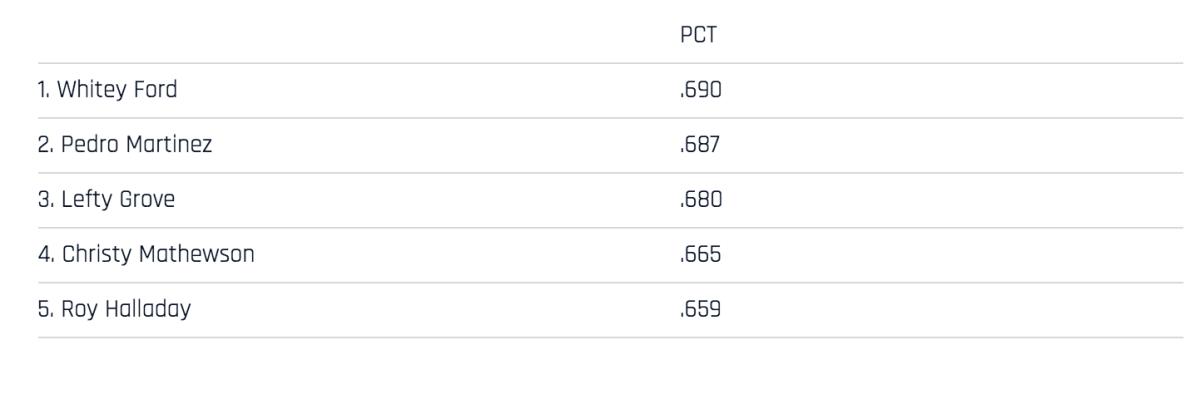Is Roy Halladay a First-Ballot Hall of Famer? Six Big Questions for This Year's Ballot

Roy Halladay was the best starting pitcher in baseball for at least a decade, won two Cy Young Awards, threw a perfect game and only the second no-hitter in postseason history, practically invented a style of power pitching that others copied, had no peers when it came to completing games, and is among the 14 best starting pitchers at preventing earned runs.
That’s a Hall of Famer. Yet because Halladay did not pitch a full season until he was 25 and because his shoulder gave out when he was 35, he accumulated “only” 203 wins and “only” 2,749.1 innings–totals that make his first-year induction a question.
Monday was Hall of Fame Snail Mail Day. The Baseball Hall of Fame and Museum dropped off at the Cooperstown post office the 400 or so ballots to voting members of the Baseball Writers Association of America, including my 26th. Here are the biggest questions related to this year’s ballot.
Will Mariano Rivera become the first unanimous Hall of Famer?
Three years ago Ken Griffey Jr. missed unanimous selection by only three ballots. Just because it’s never happened doesn’t mean it can’t. Rivera, one of the few to ever play the game who was undoubtedly the best at his given job (relief pitching), has a chance.
VERDUCCI: Exit Sandman, Baseball Bids Adieu to Mariano Rivera
Will Edgar Martinez get elected in his last year of eligibility?
The answer appears to be yes, given that he missed the 75% threshold for enshrinement by only 20 votes last year and will get the “last-year bump” afforded most all candidates.
Will Mike Mussina and Curt Schilling make it?
Probably not yet, though Mussina, with 63.5% last year, is on the bubble. Schilling’s support has been woefully inadequate given his playing record–not more than 52.3% in six years.
Will the Steroid Guys get in?
Not this year. Barry Bonds and Roger Clemens saw a jump in support two years ago when the voting roll was culled of older writers, but only about a 3% improvement last year (to 56 and 57%, respectively.) They’ll get three more ballots after this one. Manny Ramirez, Gary Sheffield and Sammy Sosa have no shot.
Will another first-timer join Rivera in getting elected?
The answer to this question should be yes–Halladay should go in with Rivera. The Class of ’19 looks like Rivera, Martinez and Halladay, with Mussina possibly joining them, especially because Halladay’s candidacy should benefit Mussina.
It was only a year and two weeks ago that Halladay died when he crashed his plane into waters off Florida. He was 40 years old. The autopsy revealed Halladay had amphetamines, morphine and an insomnia drug in his system at the time of the crash. His death, and the reckless circumstances of it, should have no bearing on how his playing career is judged by the baseball writers.
Halladay was a dominant wizard on the mound. When he accepted a demotion to Class-A ball in 2001, he lowered his arm angle and changed his style of pitching from a traditional four-seam fastball/curveball pitcher to a sinker/cutter machine. His ability to make the ball move both left and right with velocity on both sides of the plate–the scissors effect–became the preferred template of pitching in the 2000s. Derek Jeter called him the toughest pitcher he ever faced, and he was not alone is that evaluation.
VERDUCCI: The Humility and Ferocity of Roy Halladay
Halladay made his Hall of Fame case not on longevity but on a 10-year run that is among the best ever by a starting pitcher, especially when you consider his numbing efficiency. We might never again see pitching how Halladay did it at his best: completing one out of every five starts, throwing 67% strikes and winning 70% of his decisions.
Among the other first-timers, Todd Helton, Lance Berkman and Andy Pettitte all have strong Hall of Fame arguments. But Helton is a lesser candidate than Larry Walker, who couldn’t overcome the Coors Field bias; Berkman is Jim Edmonds without the elite defense; and Pettitte is an admitted PED user with an ERA+ of 117, which trails the likes of David Cone, Tim Hudson and Kevin Appier.
Is Halladay a Hall of Famer? These numbers answer the question
Strikeout to walk ratio:

Winning percentage:

• There have been 160 pitchers who threw 2,700 innings since 1900. Only 16 of them have an ERA+ of 130 or better. All of them are in the Hall of Fame except Clemens and Halladay, who ranks 14th, just ahead of Carl Hubbell, Hal Newhouser, Tom Seaver and Bob Gibson.
• Among all pitchers with 2,700 innings since 1900, only two rank among the five best pitchers in strikeout-to-walk rate and winning percentage: Pedro Martinez and Halladay.
• Since the World Series began in 1903, Halladay has the greatest winning percentage of any pitcher who never played in the World Series (minimum 350 starts).
• Over a 10-year peak (2002-11), Halladay led all pitchers in wins (170), winning percentage (.694), complete games (63; nobody else had more than 33), shutouts (18; nobody else had more than 12), and FIP (3.12). In those 10 years he made eight All-Star teams and finished in the top five in Cy Young voting seven times.
• He was the last of a breed. In the wild-card era (since 1995), nobody has more complete games than Halladay (67) and only Randy Johnson and Schilling have more starts with at least eight innings than Halladay (121).
